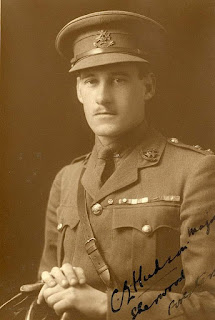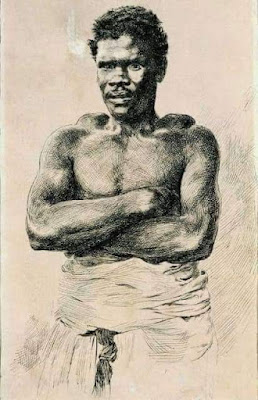WE REMEMBER Lieutenant-Colonel Charles Edward Hudson
Lieutenant-Colonel Charles Edward Hudson, VC, CB, DSO & Bar, MC, 11th (Service) Battalion, Sherwood Foresters (The Nottinghamshire and Derbyshire Regiment)
Charles Edward Hudson was born on the 29th May 1892 in Derby, Derbyshire the second son and third child of Lieutenant Colonel Herbert Edward Hudson of the Sherwood Foresters (Nottinghamshire and Derbyshire Regiment) and Mrs. Hudson. He was educated at a preparatory school in East Grinstead, Surrey, and later at Sherborne School, Dorset, which he attended from September 1905 to July 1910.
Hudson did not stand out during his time at Sherborne School, and later recounted in his journal that he was morbidly afraid of physical pain and that it was not until he had been at Sherborne for some years that he was able to overcome his fears.
After leaving Sherborne School, Hudson went to the Royal Military College, Sandhurst, but did not finish the one-year course owing to the death of his father. Instead he went to Ceylon and from 1912 to 1914 worked as an apprentice tea planter, also engaged in the first experimental rubber planting on the island. There, he served part-time in the Ceylon Mounted Rifles, in an independent section formed of six young Europeans in the district he was working.
On the outbreak of the war in August 1914, Hudson returned to England and was granted a commission as a Temporary Second Lieutenant in his father's regiment, the Sherwood Foresters, on the 17th November 1914.
He then embarked on a series of rapid promotions when he was then made a Temporary Lieutenant on the 8th February 1915, a Temporary Captain on the 11th October 1915, Acting Major on the 21st November 1916, permanent Captain in the Regular Army on the 13th May 1917 and Temporary Lieutenant Colonel on the 8th March 1918, ending the war as an Acting Lieutenant Colonel, having been promoted on the 29th September.
Initially he had been posted to the newly formed 11th (Service) Battalion, which had been raised in Derby on the 3rd October 1914, and was comprised of men mainly from the Derbyshire and Nottinghamshire coalfields. After 10 months of training the unit went to France, arriving on the 27th August 1915, and formed part of the 70th Brigade, 23rd Division.
Hudson was struck down with a bout of malaria almost as soon as he arrived in France and was due to be evacuated home but instead he discharged himself from hospital and re-joined the battalion. The unit’s first tour of duty in the trenches took place in the Armentieres sector and it was here that Hudson’s Company Commander was killed by a sniper and he found himself taking his place.
The 11th Sherwood Foresters were involved in the Battle of Loos, but in a minor role and in March 1916, they were moved down to the Somme area where they were temporarily posted to the 8th Division, along with the rest of the Brigade, for experience. They stayed with the 8th Division, and were then placed into the Reserve for the opening day of the Somme offensive, but they were active in the attack against Mouquet Farm where the battalion suffered 500 casualties. The battalion were withdrawn from the battle and re-joined the 23rd Division, and spent a brief time in Belgium, but were back on the Somme on the 18th September. Just over a week after arriving at the Front the 23rd Division were ordered to attack and capture the village of Le Sars. In a preliminary attack, Hudson and his men, who included Edward Brittain MC, who was wounded in the attack and was the brother of Vera Brittain, captured a trench known as 26th Avenue, and it was for his role in this attack that he was awarded the Military Cross.
"For conspicuous gallantry in action. He led his company with great courage and initiative, capturing two enemy bombing posts. He has on many previous occasions done very fine work." - London Gazette, 25 November 1916
In November 1916, the 11th Sherwood Foresters returned to the Ypres Salient, and by now Hudson was in the role of Acting Major. The battalion were involved in the Battle of Messines on the 7th June 1917, and it was that Hudson added to his MC with his first Distinguished Service Order.
“For conspicuous gallantry and devotion to duty. During an attack and before the objective was gained, he showed great prompititude and disregard for his own safety in reorganising his battalion and leading it forward to the objective, which was secured and consolidated through his successful efforts. He has on many occasions showed capacity of the highest military value, notably in repulsing hostile counter-attacks upon his battalion at a critical moment.” - London Gazette, 16th August 1917
Around the same time his award was being published, Hudson performed the deeds and actions that led to his second DSO during the opening phases of the Third Battle of Ypres (Passchendaele) and the citation reads:
“For conspicuous gallantry and devotion to duty. He was in command of a sector of the front line for several days during an action, and organised and carried out the defence of the position under continuous and violent enemy shelling. It was entirely due to his organisation and personal supervision of the work that the line was able to resist heavy enemy counter-attacks. He showed splendid leadership and great energy and courage.” - London Gazette, 26 November 1917.
Hudson was awarded the VC for his actions on the 15th June 1918 near Asiago, Italy, during an attack when the enemy had penetrated the front line. Hudson collected and personally led various headquarter details such as orderlies, servants, and runners to deal with the situation. He rushed a position with only two men, shouting to the enemy to surrender, some of whom did. He was severely wounded by a bomb that exploded on his foot. In great pain he gave directions for a successful counter-attack that captured about 100 prisoners and six machine-guns. For this, he was awarded the Victoria Cross. The citation appeared in a supplement to the London Gazette on 11 July 1918.
After the war, Hudson, against advice volunteered to serve in North Russia during the Allied intervention in the Russian Civil War, where he was deployed as a Brigade Staff Officer under the command of Brigadier General Edmund Ironside at Archangelsk. Returning to England, in 1920 Hudson married Gladys Lee, from Glendale, Northumberland, who he had first met in London after having been wounded in Italy in 1918. They had two sons, John Patrick Charles, born on the 11th April 1922, and Miles Matthew Lee, born on the 17th August 1925. Their first years of marriage, spent in Derby, were difficult, and Hudson chose to remain in the army, although the pay was barely sufficient, and both he and his wife had to live on army rations.
The first few years of Hudson's service as a Regular Army officer were spent mainly on regimental duties, as adjutant to his regiment's 3rd (Militia) Battalion, holding this post from 11 March 1920 until 10 March 1923. He attended the Staff College, Camberley from 1926 to 1927, but Hudson's time there was not particularly distinguished, and by the end of his first year he was almost dropped from the course, for being either consistently lazy or lacking in interest. Soon after graduating from the Staff College, Hudson returned to his regiment's 1st Battalion, then stationed in Northern Ireland, serving there for six months, before he transferred on the 27th July 1928 to the King's Own Scottish Borderers, with the rank of major, after being told that there was little chance of promotion in his own regiment. After serving with Malaya Command as a Staff Officer from 1930 to 1932, he was promoted to Brevet Lieutenant Colonel on the 1st January 1932. He became a Chief Instructor (GSO3) at the Royal Military College, Sandhurst from the 31st January 1933 until the 31st January 1937, and then returned to the 2nd Battalion of his regiment, serving in Catterick, North Yorkshire, before moving down to Portsmouth to become part of the 9th Infantry Brigade, commanded by Brigadier Bernard Montgomery.
Soon after the outbreak of the Second World War in September 1939, Hudson led his brigade overseas to France as part of the British Expeditionary Force. The brigade saw action throughout May 1940, when the German Army launched its invasion of France, which resulted in the BEF, being forced to retreat to Dunkirk, from where it was evacuated to England in late May/early June. For his services in France and Belgium Hudson was made a Companion of the Order of the Bath (CB) on the 11th July. With the threat of a German invasion of the United Kingdom, Hudson's brigade commenced anti-invasion duties, including beach defence, until mid-December when Hudson received his first divisional command.
Promoted to the acting rank of major general on 14 December, Hudson became GOC of the 46th Infantry Division, a second-line Territorial Army (TA) formation, Formed in October 1939 as a duplicate of the 49th (West Riding) Infantry Division, the 46th Division comprised the 137th, 138th and 139th Infantry Brigades, along with supporting divisional troops. The division, minus its divisional troops, had fought in France with the BEF, sustaining heavy casualties and after being evacuated, was then serving in Scotland under Scottish Command, reorganising after its heavy losses. Soon after Hudson became GOC, in early January 1941 the 46th Division moved to Cambridgeshire, later Norfolk, However, Hudson only held the command until May 1941, after a dispute with a senior officer which eventually resulted in his demotion to the substantive rank of Colonel, and he never again held a divisional command, nor did he ever regain his rank of Major General.
After this demotion, he briefly commanded the 159th Infantry Brigade, part of the TA 53rd (Welsh) Infantry Division, then serving in Northern Ireland, but was soon sent to command the 182nd Brigade, part of the 61st Infantry Division, another TA formation which was also serving in Northern Ireland, as part of British Troops in Northern Ireland. The division returned to the mainland in February 1943, moving to Essex and took part in Exercise Spartan, and moved to Kent in May, and the division was initially selected to play a role in Operation Overlord, the Allied invasion of Normandy, only to be reduced to the Lower Establishment soon after, becoming essentially a training formation with the intention of supplying replacements to overseas units. Handing over command of the 182nd Brigade in late November, he became aide-de-camp to King George VI from 1944 until his retirement from the army in 1946, a year after the war had ended.
Hudson retired to Devon and lived at Kerswell House, Chudleigh, which burnt down after he left a smouldering cigarette in an ashtray, but after the fire the Hudson’s moved to Denbury Manor, Newton Abbott. From 1949 until 1954 he was appointed County Commissioner of the Devon St. John Ambulance, Deputy Lord Lieutenant of the county and a JP.
He died whilst on a family holiday in the Scilly Isles on the 4th April 1959, aged 66. He had been taken ill and was rushed by motor launch to St. Mary’s Hospital on the islands, but died of coronary thrombosis. Hudson was buried at St. Mary's Church Denbury in South Devon.
On Wednesday, 28th May 2003, the surviving son of Major-General Charles Hudson donated his father's VC medal group to the Regimental Museum of the Sherwood Foresters based in Nottingham Castle. The group was handed over into the care of Colonel John Hackett of the Worcestershire and Sherwood Foresters Regiment and chairman of the Museum Trustees. Hudson was also awarded the Croix de Guerre, Italian Silver Medal of Military Valour and the Order of St John of Jerusalem (Commander).








Comments
Post a Comment